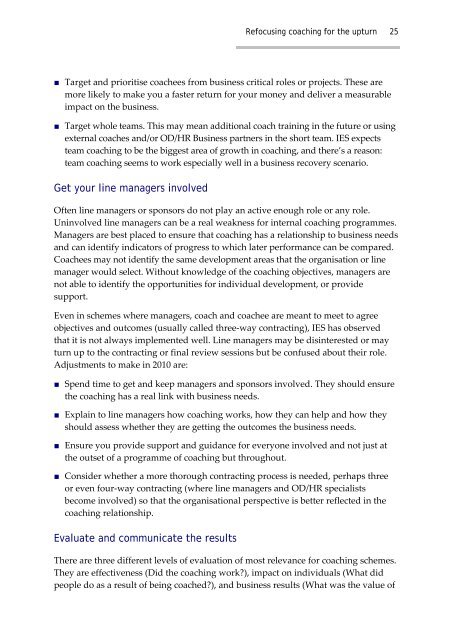PDF of this item - The Institute for Employment Studies
PDF of this item - The Institute for Employment Studies
PDF of this item - The Institute for Employment Studies
- No tags were found...
You also want an ePaper? Increase the reach of your titles
YUMPU automatically turns print PDFs into web optimized ePapers that Google loves.
Refocusing coaching <strong>for</strong> the upturn 25■ Target and prioritise coachees from business critical roles or projects. <strong>The</strong>se aremore likely to make you a faster return <strong>for</strong> your money and deliver a measurableimpact on the business.■ Target whole teams. This may mean additional coach training in the future or usingexternal coaches and/or OD/HR Business partners in the short team. IES expectsteam coaching to be the biggest area <strong>of</strong> growth in coaching, and there’s a reason:team coaching seems to work especially well in a business recovery scenario.Get your line managers involvedOften line managers or sponsors do not play an active enough role or any role.Uninvolved line managers can be a real weakness <strong>for</strong> internal coaching programmes.Managers are best placed to ensure that coaching has a relationship to business needsand can identify indicators <strong>of</strong> progress to which later per<strong>for</strong>mance can be compared.Coachees may not identify the same development areas that the organisation or linemanager would select. Without knowledge <strong>of</strong> the coaching objectives, managers arenot able to identify the opportunities <strong>for</strong> individual development, or providesupport.Even in schemes where managers, coach and coachee are meant to meet to agreeobjectives and outcomes (usually called three‐way contracting), IES has observedthat it is not always implemented well. Line managers may be disinterested or mayturn up to the contracting or final review sessions but be confused about their role.Adjustments to make in 2010 are:■ Spend time to get and keep managers and sponsors involved. <strong>The</strong>y should ensurethe coaching has a real link with business needs.■ Explain to line managers how coaching works, how they can help and how theyshould assess whether they are getting the outcomes the business needs.■ Ensure you provide support and guidance <strong>for</strong> everyone involved and not just atthe outset <strong>of</strong> a programme <strong>of</strong> coaching but throughout.■ Consider whether a more thorough contracting process is needed, perhaps threeor even four‐way contracting (where line managers and OD/HR specialistsbecome involved) so that the organisational perspective is better reflected in thecoaching relationship.Evaluate and communicate the results<strong>The</strong>re are three different levels <strong>of</strong> evaluation <strong>of</strong> most relevance <strong>for</strong> coaching schemes.<strong>The</strong>y are effectiveness (Did the coaching work?), impact on individuals (What didpeople do as a result <strong>of</strong> being coached?), and business results (What was the value <strong>of</strong>
















